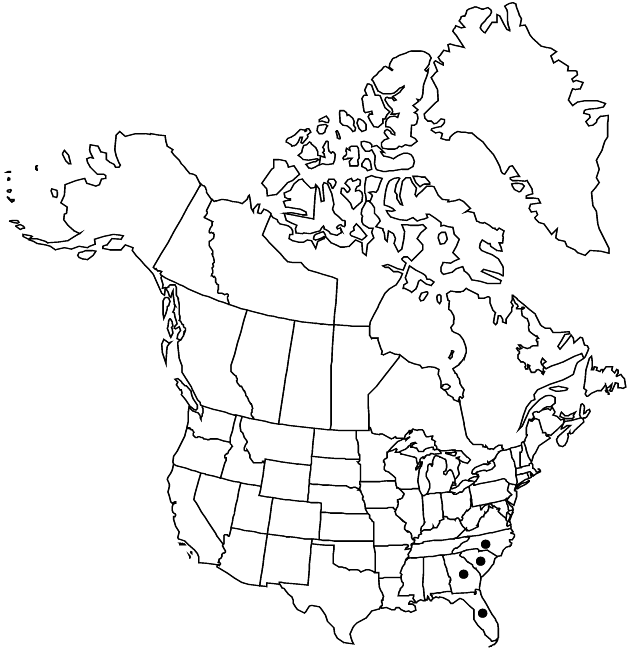Difference between revisions of "Eurybia paludosa"
Phytologia 77: 261. 1995.
FNA>Volume Importer |
FNA>Volume Importer |
||
| Line 57: | Line 57: | ||
|publication year=1995 | |publication year=1995 | ||
|special status= | |special status= | ||
| − | |source xml=https://jpend@bitbucket.org/aafc-mbb/fna-data-curation.git/src/ | + | |source xml=https://jpend@bitbucket.org/aafc-mbb/fna-data-curation.git/src/f50eec43f223ca0e34566be0b046453a0960e173/coarse_grained_fna_xml/V19-20-21/V20_868.xml |
|tribe=Asteraceae tribe Astereae | |tribe=Asteraceae tribe Astereae | ||
|genus=Eurybia | |genus=Eurybia | ||
Revision as of 20:31, 16 December 2019
Plants 20–80 cm; in clumps and clones, eglandular; rhizomes creeping, herbaceous and thin, becoming thick and woody, scaly. Stems 1–10+, erect, often reddish, simple, straight (brittle), proximally glabrous, glabrescent, or sparsely strigillose, distally strigillose or ± villoso-hirsute (at least in arrays). Leaves basal and cauline, firm, only midnerves evident, margins indurate, entire or sometimes remotely spinulose-serrate, scabrous, spines indurate, ± pronounced, apices mucronate or indurate, abaxial faces glabrous or scabrous, adaxial sparsely hirtellous, distal often more hairy; basal and proximalmost cauline withering by flowering, petioles (often marcescent, to 20 mm), bases sheathing, blades elliptic to lanceolate (basal) or linear-lanceolate, ± arcuate (proximal), 15–103 × 5–9 mm, bases cuneate, apices obtuse (basal) to acute; cauline progressively sessile (petioles more winged) and reduced, blades lanceolate or linear-lanceolate to linear, ± arcuate, 18–132+ × 2–6 mm, margins sometimes revolute, apices acute. Heads (1–)4–10+ in open, corymbiform arrays, seldom borne singly, with ascending branches. Peduncles ascending, usually mostly 1–10+ cm (seldom not elongating, sometimes those of young heads appearing short or absent), thin, hirtello-puberulent to villoso-hirsute; bracts 2–5, often 1–2 subtending heads, sometimes phyllary-like (bases pale, indurate). Involucres campanulate, 9–11 mm, much shorter than pappi. Phyllaries 40–65+ in 4–5 series, lanceolate or oblong (outer) to linear-oblanceolate or linear (inner), unequal, membranous, bases indurate, rounded (particularly outer), green zones well defined, slightly expanded in distal 1/3–2/3 (foliaceous), reaching margins (outer wholly foliaceous, outermost are bracts subtending heads) to 1/6 or less and not reaching margins or none (inner), margins sometimes distally purplish (particularly inner), indurate, narrowly scarious, erose proximally to nearly completely so (inner), densely ciliate proximally (scarious part) to distally scabrous (foliaceous part), apices loose and often spreading, sometimes squarrose, obtuse to sometimes acute, mucronate, faces sparsely to densely strigillose. Ray florets 15–35; corollas deep lavender to purple, (10–)15–20 × 1–2.3 mm. Disc florets 25–60; corollas yellow, 5.5–7 mm, slightly ampliate, tubes much shorter than cylindro-funnelform throats, lobes spreading, lanceolate-acuminate, 0.75–1.1 mm. Cypselae stramineous to tawny, cylindric to narrowly obovoid, slightly compressed, 2.3–3.6 mm, ribs 10–16, sparsely strigillose; pappi of stramineous (firm, sometimes apically clavellate) bristles 5–6.7 mm, ± equaling disc corollas. 2n = 36.
Phenology: Flowering late summer–fall.
Habitat: Moist savannas, margins of pools and swamps, low pinelands, seldom on sand hills of coastal plains, open hammocks
Elevation: 0–100 m
Distribution

Fla., Ga., N.C., S.C.
Discussion
Eurybia paludosa is often confused with E. hemispherica, with which it is closely related. It is present on the Atlantic coastal plain from North Carolina to northeastern Florida. The two species are disjunct geographically and ecologically, even when they occur in the same states. In North Carolina, for instance, E. paludosa is coastal while E. hemispherica is found in the mountains. In northern Florida, the former is found only in Nassau County, while the latter is present only in the western panhandle. Their ranges do not overlap.
Selected References
None.